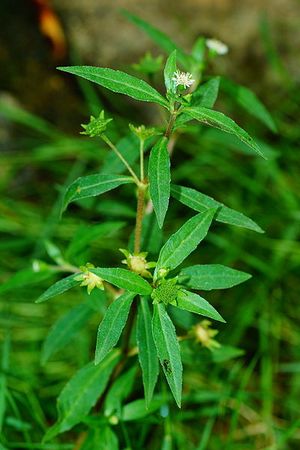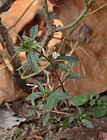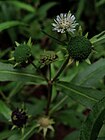Note: This is a project under development. The articles on this wiki are just being initiated and broadly incomplete. You can Help creating new pages.
Difference between revisions of "Eclipta prostrata - Bhrngaraja"
(→List of Ayurvedic medicine in which the herb is used) |
(→List of Ayurvedic medicine in which the herb is used) |
||
| Line 46: | Line 46: | ||
==List of Ayurvedic medicine in which the herb is used== | ==List of Ayurvedic medicine in which the herb is used== | ||
| + | * [[Bhringamalakadi taila]] | ||
| + | * [[Bhringarajasavam]] | ||
| + | * [[Manjishtadi kwath]] | ||
| + | <ref name="Ayurvedic preparations"/> | ||
==Where to get the saplings== | ==Where to get the saplings== | ||
Revision as of 13:43, 6 June 2019
Eclipta prostrata commonly known as false daisy, yerba de tago, and bhrngraja, is a species of plant in the sunflower family. It is widespread across much of the world. It is widely distributed throughout India, Nepal.
Contents
- 1 Uses
- 2 Parts Used
- 3 Chemical Composition
- 4 Common names
- 5 Properties
- 6 Habit
- 7 Identification
- 8 List of Ayurvedic medicine in which the herb is used
- 9 Where to get the saplings
- 10 Mode of Propagation
- 11 How to plant/cultivate
- 12 Commonly seen growing in areas
- 13 Photo Gallery
- 14 References
- 15 External Links
Uses
Loss of appetite, Asthma, Productive cough, Hyperlipidemia, Mild hypertension, Intestinal worm, Jaundice, Piles, Abdominal pain, Hairfall, Preature greying of hair, Lucoderma.
Parts Used
Chemical Composition
Wedelolactone, Luteolin, Apigenin, Triterpenoids – Eclalbatin, alpha-amyrin, oleanolic acid, ursolic acid, Flavonoids – apigenin and luteolin, Wedelolactone,Echinocystic acid glycosides, β-Sitosterol, Daucosterol [1]
Common names
| Language | Common name |
|---|---|
| Kannada | Ajagara |
| Hindi | Bhrngaraj, Kesharaj |
| Malayalam | Kannunni |
| Tamil | Karisilanganni, Kavanthakara |
| Telugu | Galagara |
| Marathi | NA |
| Gujarathi | NA |
| Punjabi | NA |
| Kashmiri | NA |
| Sanskrit | Bhrngaraja |
| English | False Daisy, Trailing eclipta |
Properties
Reference: Dravya - Substance, Rasa - Taste, Guna - Qualities, Veerya - Potency, Vipaka - Post-digesion effect, Karma - Pharmacological activity, Prabhava - Therepeutics.
Dravya
Rasa
Tikta (Bitter), Katu (Pungent)
Guna
Laghu (Light), Ruksha (Dry)
Veerya
Ushna (Hot)
Vipaka
Katu (Pungent)
Karma
Prabhava
Habit
Identification
Leaf
| Kind | Shape | Feature |
|---|---|---|
| Simple | Lanceolate | Leaf Apex is Acute, Leaf Base is Cuneate and Leaf Margin is Serrate-dentate. |
.[2]
Flower
| Type | Size | Color and composition | Stamen | More information |
|---|---|---|---|---|
| bisexual | 2.5 cm long | white | 5-20 | In axillary or terminal 1-3 capitula; white. Flowering from December-May |
Fruit
| Type | Size | Mass | Appearance | Seeds | More information |
|---|---|---|---|---|---|
| oblong achene | An oblong achene, 3-quetrous, hairy above. Fruiting January onwards | {{{6}}} |
Other features
List of Ayurvedic medicine in which the herb is used
Where to get the saplings
Mode of Propagation
How to plant/cultivate
Requires a damp to wet soil and a position in some shade[4]
Commonly seen growing in areas
Poorly drained area, Wet areas.
Photo Gallery
v
References
- ↑ "chemical composition"
- ↑ "morphology"
- ↑ Cite error: Invalid
<ref>tag; no text was provided for refs namedAyurvedic preparations - ↑ "Cultivation Details"
External Links
- Pages with reference errors
- Ayurvedic Herbs known to be helpful to treat Loss of appetite
- Ayurvedic Herbs known to be helpful to treat Asthma
- Ayurvedic Herbs known to be helpful to treat Productive cough
- Ayurvedic Herbs known to be helpful to treat Hyperlipidemia
- Ayurvedic Herbs known to be helpful to treat Mild hypertension
- Ayurvedic Herbs known to be helpful to treat Intestinal worm
- Ayurvedic Herbs known to be helpful to treat Jaundice
- Ayurvedic Herbs known to be helpful to treat Piles
- Ayurvedic Herbs known to be helpful to treat Abdominal pain
- Ayurvedic Herbs known to be helpful to treat Hairfall
- Ayurvedic Herbs known to be helpful to treat Preature greying of hair
- Ayurvedic Herbs known to be helpful to treat Lucoderma
- Herbs with Young shoots used in medicine
- Herbs with Leaves used in medicine
- Herbs with common name in Kannada
- Herbs with common name in Hindi
- Herbs with common name in Malayalam
- Herbs with common name in Tamil
- Herbs with common name in Telugu
- Herbs with common name in Sanskrit
- Herbs with common name in English
- Habit - Annual plant
- Index of Plants which can be propagated by Seeds
- Herbs that are commonly seen in the region of Poorly drained area
- Herbs that are commonly seen in the region of Wet areas
- Herbs
- Asteraceae





